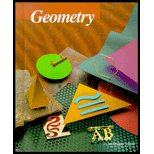
Concept explainers
To write the similar program for previous exercise in another language than BASIC.
Explanation of Solution
Given:
Break a stick into three pieces to get the probability that you can join the pieces end-to-end to form a triangle. If the sum of the length of any two pieces is less than or equal to that of the third, a triangle can’t be form. This is known as Triangle Inequality. By an experiment your class can estimate the probability that three pieces of broken stick will form a triangle.
Calculation:
Let D, N, I, X, Y, R, S and T variables used in program. Where D stands for number of sticks you have to break, N stands for first end of stick that is 0, I stands for variable of for loop assign from 1 to D, X and Y are stand for the length of points distance from initial point that is 0, R assigned as X, S assigned as Y − R and T assigned for 1 − R − S. Consider the program below-
The given program in C programming language is
Program:
#include <stdio.h>
#include <math.h>
#include <conio.h>
int main(int argc, char *argv[]) {
int D=0;
int N=0;
int I=1;
float X=0, Y=0, R, S, T, P;
printf("SIMULATION--BREAKING STICKS TO MAKE TRIANGL...*I);
do {
// get the random number between 0 and 1; line 70, 80
X = ((float)(rand()%100))/(float)100;
Y = ((float)(rand()%100))/(float)100;
} while (X>=Y); // if condition for X>=Y
// for lines 100-150
R = X;
S = Y-R;
T = 1-R-S;
if (R+S <= T)
continue;
if (S+T <= R)
continue;
if (R+T <= S)
continue;
N = N+1;
}
P = (float)N/(float)D;
printf("\nTHE EXPERIMENTAL PROBABILITY THAT\nA BROKEN STICK CAN FORM A TRIANGLE IS %f\n",P);
return 0;
}
Sample Output:
SIMULATION--BREAKING STICKS TO MAKE
HOW MANY STICKS DO YOU WANT TO BREAK:100
THE EXPERIMENTAL PROBABILITY THAT
A BROKEN STICK CAN FORM A TRIANGLE IS 0.260000
Output Explanation:
SIMULATION--BREAKING STICKS TO MAKE TRIANGLES
Enter number of sticks as 10 which you want to break that is value of variable D
HOW MANY STICKS DO YOU WANT TO BREAK:100
THE EXPERIMENTAL PROBABILITY THAT
Then you get the experimental probability equal to 0.260000 that is P=0.260000
A BROKEN STICK CAN FORM A TRIANGLE IS 0.260000
Chapter 6 Solutions
McDougal Littell Jurgensen Geometry: Student Edition Geometry
Additional Math Textbook Solutions
Calculus Volume 2
Statistics: The Art and Science of Learning from Data (4th Edition)
Using and Understanding Mathematics: A Quantitative Reasoning Approach (6th Edition)
An Introduction to Mathematical Statistics and Its Applications (6th Edition)
Introductory Statistics
Introductory and Intermediate Algebra for College Students (5th Edition)
 Elementary Geometry For College Students, 7eGeometryISBN:9781337614085Author:Alexander, Daniel C.; Koeberlein, Geralyn M.Publisher:Cengage,
Elementary Geometry For College Students, 7eGeometryISBN:9781337614085Author:Alexander, Daniel C.; Koeberlein, Geralyn M.Publisher:Cengage, Elementary Geometry for College StudentsGeometryISBN:9781285195698Author:Daniel C. Alexander, Geralyn M. KoeberleinPublisher:Cengage Learning
Elementary Geometry for College StudentsGeometryISBN:9781285195698Author:Daniel C. Alexander, Geralyn M. KoeberleinPublisher:Cengage Learning

